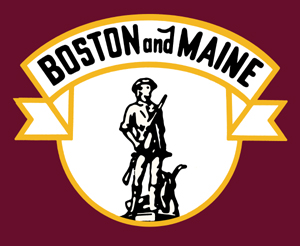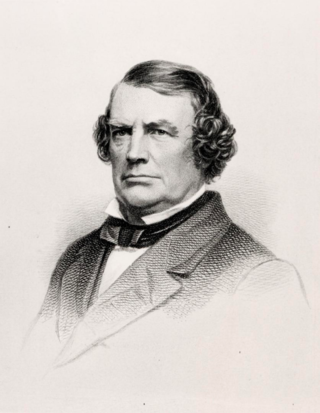
The Boston and Maine Railroad was a U.S. Class I railroad in northern New England. Originally chartered in 1835, it became part of what was the Pan Am Railways network in 1983.

The Grand Trunk Railway was a railway system that operated in the Canadian provinces of Quebec and Ontario and in the American states of Connecticut, Maine, Michigan, Massachusetts, New Hampshire, and Vermont. The railway was operated from headquarters in Montreal, Quebec, with corporate headquarters in London, United Kingdom. It cost an estimated $160 million to build. The Grand Trunk, its subsidiaries, and the Canadian Government Railways were precursors of today's Canadian National Railway.

U.S. Route 4 (US 4) is a 253-mile-long (407 km) United States Numbered Highway that runs from East Greenbush, New York, in the west to Portsmouth, New Hampshire, in the east, traversing Vermont.
The Central Vermont Railway was a railroad that operated in the U.S. states of Connecticut, Massachusetts, New Hampshire, New York, and Vermont, as well as the Canadian province of Quebec.

The St. Lawrence and Atlantic Railroad, known as St-Laurent et Atlantique Quebec in Canada, is a short-line railway operating between Portland, Maine, on the Atlantic Ocean, and Montreal, Quebec, on the St. Lawrence River. It crosses the Canada–US border at Norton, Vermont, and Stanhope, Quebec, and is owned by short-line operator Genesee & Wyoming.

The Fitchburg Railroad is a former railroad company, which built a railroad line across northern Massachusetts, United States, leading to and through the Hoosac Tunnel. The Fitchburg was leased to the Boston and Maine Railroad in 1900. The main line from Boston to Fitchburg is now operated as the MBTA Fitchburg Line; Pan Am Railways runs freight service on some other portions.

The Portland & Ogdensburg Railroad was a railroad planned to connect Portland, Maine to Ogdensburg, New York. The plan failed, and in 1880 the Vermont section was reorganized and leased by the Boston & Lowell Railroad. In 1886, the Maine and New Hampshire section was reorganized as the Portland & Ogdensburg Railway. That part was leased to the Maine Central Railroad in 1888, and in 1912 the Maine Central leased the eastern part of the Vermont section from the Boston & Maine Railroad, the successor to the B&L.

The Green Mountain Railroad is a class III railroad operating in Vermont. GMRC operates on tracks that had been owned by the Rutland Railroad and Boston and Maine Railroad. The railroad operates on a rail line between North Walpole, New Hampshire, and Rutland, Vermont. GMRC's corporate colors are green and yellow.

The New England Patriots Radio Network is a radio network which carries live game broadcasts of the New England Patriots. The network's flagship station is WBZ-FM in Boston. Bob Socci, who now does the play-by-play with former Patriots quarterback Scott Zolak providing the color commentary and former Patriots linebacker Matt Chatham and WBZ-TV/WSBK-TV sports reporter Steve Burton providing the sideline reports. Marc Bertrand and Boston Globe sports columnist Chris Gasper host the pregame, and the postgame show is hosted by Bertrand. Albert Breer and Patriots Football Weekly writers Paul Perillo is a regular guest on the network's pre-game show.

Whitehall station is an Amtrak intercity train station in the village of Whitehall, New York. It is served by the Adirondack. It has one low-level side platform with a small shelter on the east side of the track.

The Rutland and Washington Railroad was a railroad company based in Rutland, Vermont which was chartered in Vermont on November 13, 1847, and built between Rutland and Eagle Bridge in Rensselaer County, New York in 1851 and 1852. One of the company's founders was Merritt Clark, a Vermont politician, and another was Thomas Canfield, later involved with the Northern Pacific. In order to build in New York, the company, on June 24, 1850, took a perpetual rent-free lease of the franchise rights east of Salem of the Troy and Rutland Railroad, which had been chartered in that state on July 2, 1849. The remainder of the Troy and Rutland, from Salem west to Eagle Bridge, was completed in 1852 and leased to the Rutland and Washington effective July 2.

U.S. Route 4 (US 4) in the U.S. state of Vermont extends for 66.059 miles (106.312 km) between the New York state line at Fair Haven and the New Hampshire state line at White River Junction. It is one of the main arteries between New York and New Hampshire.

The Boston, Hoosac Tunnel and Western Railway was a railway company that operated in the states of New York and Vermont in the 1880s. At its peak it controlled a 61-mile (98 km) network centered on Mechanicville, New York. Plans to extend the line west to Buffalo, New York, on Lake Ontario, were never realized, and the Fitchburg Railroad, a predecessor of the Boston and Maine Railroad, acquired control of the company in 1887 and merged it in 1892.
The Rutland and Whitehall Railroad is a defunct railroad which operated in the state of Vermont. The railroad, also known as the Castleton Company, received its charter from Vermont in 1848 and opened in 1850.

John Alfred Poor was an American lawyer, editor, and entrepreneur best remembered for his association with the Grand Trunk Railway and his role in developing the railroad system in Maine. He was the older brother of Henry Varnum Poor of Standard & Poor's, who was his partner in some business ventures. John Poor was an articulate man standing 6 feet, two inches tall and weighing over 250 pounds (110 kg). He learned the geography and commerce of northern New England during travels as a young man; and developed an early appreciation for the potential of railroads. His commanding presence was enhanced by early speaking experience as a teacher and attorney. He had a unique ability to assemble the necessary resources to build early railroads, although he left the routine work of operations to others.
The Saratoga and Washington Railroad was an early railroad in the state of New York. It was chartered in 1834, opened for operation in 1848, and reorganized as the Saratoga and Whitehall Railroad in 1855. Its tracks eventually became part of the Delaware and Hudson Company.
The Whitehall and Plattsburgh Railroad was a railway company that built but did not operate two disconnected railway lines in Upstate New York in the 19th century. Its purpose, to build a 90-mile (140 km) railway line between Whitehall, New York, and Plattsburgh, New York, was realized by its successor, the New York and Canada Railroad, albeit over a different route between Port Henry, New York, and Plattsburgh. Its northern line, between Plattsburgh and Ausable, New York, became the Ausable Branch of the Delaware and Hudson Railway and was abandoned in 1981. Its southern line, between Port Henry and Ticonderoga, New York, was incorporated into the New York and Canada Railroad main line and today is part of the Canadian Pacific Kansas City's Canadian Subdivision.
The Canadian Subdivision is a railway line in the state of New York. It runs north–south along the west side of Lake Champlain from the vicinity of Schenectady, New York, to Rouses Point, New York, on the border with Quebec. While the oldest part of the line was built in 1832–1833, the majority was constructed between 1869 and 1876. Once part of the Delaware and Hudson Railway main line, today Canadian Pacific Kansas City owns the line. Amtrak's Adirondack operates over the full length, providing daily service between New York City and Montreal.














